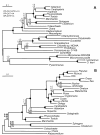Origin of land plants: do conjugating green algae hold the key?
- PMID: 21501468
- PMCID: PMC3088898
- DOI: 10.1186/1471-2148-11-104
Origin of land plants: do conjugating green algae hold the key?
Abstract
Background: The terrestrial habitat was colonized by the ancestors of modern land plants about 500 to 470 million years ago. Today it is widely accepted that land plants (embryophytes) evolved from streptophyte algae, also referred to as charophycean algae. The streptophyte algae are a paraphyletic group of green algae, ranging from unicellular flagellates to morphologically complex forms such as the stoneworts (Charales). For a better understanding of the evolution of land plants, it is of prime importance to identify the streptophyte algae that are the sister-group to the embryophytes. The Charales, the Coleochaetales or more recently the Zygnematales have been considered to be the sister group of the embryophytes However, despite many years of phylogenetic studies, this question has not been resolved and remains controversial.
Results: Here, we use a large data set of nuclear-encoded genes (129 proteins) from 40 green plant taxa (Viridiplantae) including 21 embryophytes and six streptophyte algae, representing all major streptophyte algal lineages, to investigate the phylogenetic relationships of streptophyte algae and embryophytes. Our phylogenetic analyses indicate that either the Zygnematales or a clade consisting of the Zygnematales and the Coleochaetales are the sister group to embryophytes.
Conclusions: Our analyses support the notion that the Charales are not the closest living relatives of embryophytes. Instead, the Zygnematales or a clade consisting of Zygnematales and Coleochaetales are most likely the sister group of embryophytes. Although this result is in agreement with a previously published phylogenetic study of chloroplast genomes, additional data are needed to confirm this conclusion. A Zygnematales/embryophyte sister group relationship has important implications for early land plant evolution. If substantiated, it should allow us to address important questions regarding the primary adaptations of viridiplants during the conquest of land. Clearly, the biology of the Zygnematales will receive renewed interest in the future.
© 2011 Wodniok et al; licensee BioMed Central Ltd.
Figures



Similar articles
-
Streptophyte algae and the origin of embryophytes.Ann Bot. 2009 May;103(7):999-1004. doi: 10.1093/aob/mcp044. Epub 2009 Mar 8. Ann Bot. 2009. PMID: 19273476 Free PMC article.
-
Streptophyte algae and the origin of land plants revisited using heterogeneous models with three new algal chloroplast genomes.Mol Biol Evol. 2014 Jan;31(1):177-83. doi: 10.1093/molbev/mst200. Epub 2013 Oct 17. Mol Biol Evol. 2014. PMID: 24136916
-
The chloroplast genome sequence of Chara vulgaris sheds new light into the closest green algal relatives of land plants.Mol Biol Evol. 2006 Jun;23(6):1324-38. doi: 10.1093/molbev/msk018. Epub 2006 Apr 12. Mol Biol Evol. 2006. PMID: 16611644
-
Green algae and the evolution of land plants: inferences from nuclear-encoded rRNA gene sequences.Biosystems. 1992;28(1-3):127-37. doi: 10.1016/0303-2647(92)90015-q. Biosystems. 1992. PMID: 1292658 Review.
-
Zygnematophyceae: from living algae collections to the establishment of future models.J Exp Bot. 2020 Jun 11;71(11):3296-3304. doi: 10.1093/jxb/eraa091. J Exp Bot. 2020. PMID: 32076703 Review.
Cited by
-
Polar Expansion Dynamics in the Plant Kingdom: A Diverse and Multifunctional Journey on the Path to Pollen Tubes.Plants (Basel). 2013 Mar 18;2(1):148-73. doi: 10.3390/plants2010148. Plants (Basel). 2013. PMID: 27137370 Free PMC article. Review.
-
Genome-wide analyses across Viridiplantae reveal the origin and diversification of small RNA pathway-related genes.Commun Biol. 2021 Mar 25;4(1):412. doi: 10.1038/s42003-021-01933-5. Commun Biol. 2021. PMID: 33767367 Free PMC article.
-
Cryogenian Glacial Habitats as a Plant Terrestrialisation Cradle - The Origin of the Anydrophytes and Zygnematophyceae Split.Front Plant Sci. 2022 Jan 27;12:735020. doi: 10.3389/fpls.2021.735020. eCollection 2021. Front Plant Sci. 2022. PMID: 35154170 Free PMC article.
-
Salinity-induced noise in membrane potential of Characeae Chara australis: effect of exogenous melatonin.J Membr Biol. 2015 Feb;248(1):93-102. doi: 10.1007/s00232-014-9746-9. Epub 2014 Nov 7. J Membr Biol. 2015. PMID: 25378124
-
Early photosynthetic eukaryotes inhabited low-salinity habitats.Proc Natl Acad Sci U S A. 2017 Sep 12;114(37):E7737-E7745. doi: 10.1073/pnas.1620089114. Epub 2017 Aug 14. Proc Natl Acad Sci U S A. 2017. PMID: 28808007 Free PMC article.
References
-
- Lang D, Weiche B, Timmerhaus G, Richardt S, Riano-Pachon DM, Correa LGG, Reski R, Mueller-Roeber B, Rensing SA. Genome-Wide Phylogenetic Comparative Analysis of Plant Transcriptional Regulation: A Timeline of Loss, Gain, Expansion, and Correlation with Complexity. Genome Biol Evol. pp. 488–503. - DOI - PMC - PubMed
-
- Graham LE. Origin of land plants. New York: John Wiley & Sons, Inc.; 1993.
-
- Kenrick P, Crane PR. The origin and early diversification of land plants. Washington, London: Smithsonian Institution Press; 1997.
Publication types
MeSH terms
LinkOut - more resources
Full Text Sources
Other Literature Sources

